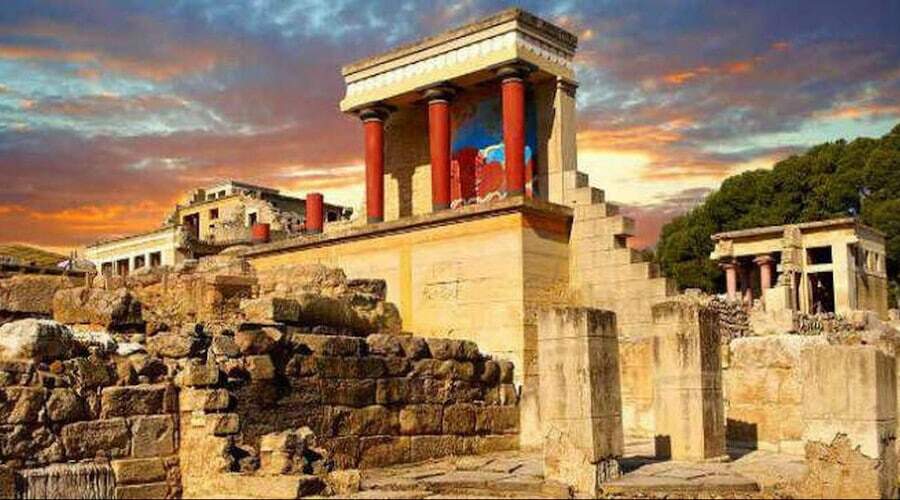According to tradition, it was the seat of King Minos and the capital of his realm. Knossos, located on the island of Crete, five kilometres southeast of Heraklion city, is one of the most significant archaeological sites of the ancient Minoan civilization. Often referred to as Europe’s oldest city, Knossos was the largest Bronze Age site on Crete and served as the political, religious, and cultural centre of the Minoans. This palace complex dates back to around 1900 BCE and is particularly famous for its intricate layout, vibrant frescoes, advanced architectural features, and association with Greek mythology.
The Palace of Knossos
The Palace of Knossos was a sprawling structure covering approximately 20,000 square meters, with a maze-like design of over a thousand rooms. Its architecture reveals the Minoans’ sophisticated engineering skills, including multi-story buildings, storage areas, elaborate drainage systems, and ventilation shafts. The palace complex included grand courtyards, religious sanctuaries, living quarters, storerooms, and workshops. Central to Minoan life, the palace hosted administrative, economic, and ceremonial functions.
Art and Frescoes
One of the most captivating aspects of Knossos is its colourful frescoes, which adorn the palace walls. These frescoes depict scenes of nature, animals, religious ceremonies, and Minoan life. Notable images include the “Bull-Leaping Fresco,” which shows a figure vaulting over a bull—a symbol that represents ritualistic activities or athletic feats. The artwork demonstrates the Minoans’ admiration for nature, grace, and dynamism in their expression.
Myths and Legends
Knossos is deeply intertwined with Greek mythology, particularly with the legend of King Minos, who is said to have ruled there. According to myth, King Minos ordered the construction of a labyrinth beneath the palace to imprison the Minotaur—a monstrous creature that was half-man, half-bull. This labyrinth is believed to have inspired the palace’s design, with its confusing corridors and rooms. The hero Theseus is famously said to have killed the Minotaur in this labyrinth with the help of Minos’s daughter, Ariadne, who provided him with a thread to navigate the maze.
The Decline of Knossos
Knossos flourished until around 1450 BCE, when it began to decline, possibly due to a natural disaster such as the eruption of Thera (modern-day Santorini) or an invasion by the Mycenaeans from mainland Greece. The palace was eventually abandoned, and by around 1375 BCE, it ceased to function as a major centre.
Excavation and Restoration
In the early 20th century, British archaeologist Sir Arthur Evans excavated Knossos, revealing the ancient city’s grandeur. Evans controversially restored parts of the palace, using reinforced concrete to recreate some walls and frescoes. While this approach was criticised for altering the site’s authenticity, it also helped give visitors an idea of the palace’s original appearance.
Knossos Today
Today, Knossos remains one of the most visited archaeological sites in Greece. It offers a window into the Minoan civilization, its artistic achievements, and the myths that have shaped the history of the ancient Mediterranean. The site fascinates archaeologists, historians, and tourists alike, providing invaluable insights into the lives and beliefs of one of Europe’s earliest advanced civilizations.




